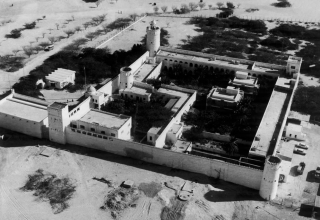
Qasr Al Hosn Fort

Qasr al Hosn began life in the 18th century as a coral and sea stone watchtower built by the Bani Yas tribes in Abu Dhabi. Its role was to command coastal trade routes and to protect the settlement that had grown up around the water sources they discovered on the island.
With the watchtower in place, new settlements began to emerge and the community expanded. The Bani Yas tribe moved to the coast, and Sheikh Shakhbut Bin Dhiyab, who ruled Abu Dhabi from 1795 to 1816, transformed the watchtower into an impenetrable fort.
The fort was made from coral and sea stones, and covered with a render made from lime, local sand and crushed sea shells. Due to the shell’s reflective qualities, the fort’s walls would sparkle in the sun, offering a welcome coastal navigational tool for the region’s merchants. Mangrove was chosen to make the flooring and roof structure due to its natural strength and durability.
The fort underwent stages of expansion throughout the 18th and 19th centuries. Sheikh Tahnoon Bin Shakhbut (1818-1833) enlarged the fort in the early 19th century and soon the small village of palm huts became a town of more than five thousand residents. In addition, Sheikh Saeed Bin Tahnoon (1845-1855) carried out further enlargements and improvements of the fort in the 1850s.
After a period of hardship following the decline in the pearling industry, Qasr al Hosn went through a period of expansion during the exploration and discovery of oil between 1939 and the 1950s. Sheikh Shakhbut Bin Sultan Al Nahyan (1928-1966) used oil revenues to build an iconic palace that enclosed the initial fort.
The Father of the Nation, the late Sheikh Zayed Bin Sultan Al Nahyan, ordered a large-scale renovation of Qasr al Hosn, transforming it from the royal residence into a museum and repository of collections relating to Abu Dhabi and the Gulf.
One of the most ingenious aspects of the structure is its traditional ‘Barjeel’ ventilation system – effectively an early form of air conditioning. Recessed arches built into the exterior walls would direct the prevailing sea breezes into the interior rooms via a network of narrow airways.
The guided fort tours provide a demonstration of this system for visitors so that they can appreciate this intelligent form of local construction.
The age of the fort and its importance to Abu Dhabi’s history means that the conservation team has to take every care to avoid any damage to the authentic fabric of the original structure. This is especially true for interventions on the early watchtower, which is described as the biggest challenge for the architects and conservators due to the survival of so much of its original stonework.